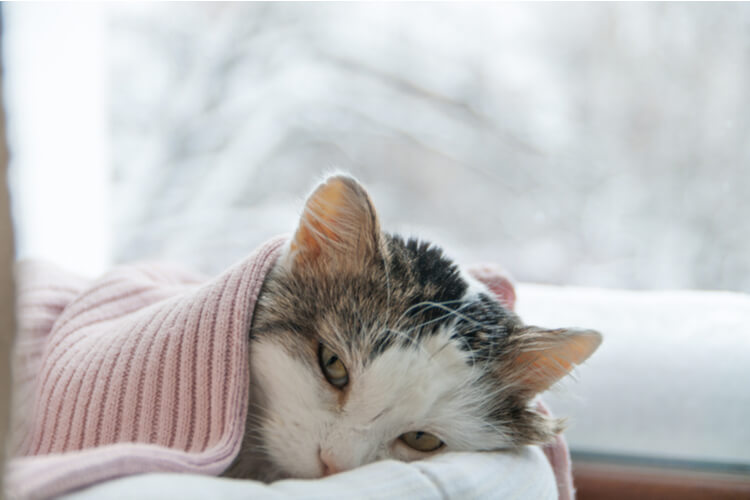When it comes to cold weather, cats have a remarkable ability to adapt and keep themselves warm. Their fur, which acts as a natural insulation, helps to regulate their body temperature and keep them comfortable in various climates. Additionally, cats have a higher body temperature than humans, typically ranging between 100.5°F and 102.5°F, which further aids in their ability to withstand colder temperatures.
However, despite these natural adaptations, cats can still feel the effects of extreme cold. Factors such as age, health, and breed can influence a cat’s tolerance to cold weather. Older cats and those with certain health conditions may be more susceptible to the cold and require extra care and attention during colder months.
To ensure your feline friend stays warm and cozy during chilly weather, it’s important to create a comfortable living environment. This can include providing them with warm bedding, keeping the indoor temperature regulated, and limiting their exposure to drafts. Additionally, providing access to a safe and enclosed outdoor space, equipped with shelter and insulation, can allow cats to enjoy the outdoors while still staying warm.
Fur and Body Temperature Regulation

The fur acts as a barrier, trapping a layer of air close to the cat’s body, which helps to retain heat. Additionally, a cat’s fur can fluff up in cold weather, creating an extra layer of insulation. This adaptation allows cats to regulate their body temperature effectively.
Furthermore, cats have a unique body mechanism known as piloerection, which refers to the involuntary raising of their fur. When a cat feels cold, their fur stands on end, creating a thicker layer and trapping more air. This response helps them conserve body heat and maintain a comfortable temperature.
In addition to their fur, cats also have specialized blood vessels called arteriovenous anastomoses. These vessels allow blood to bypass the skin’s surface and flow directly to the vital organs, preventing heat loss. This mechanism ensures that the cat’s core body temperature remains stable even in cold conditions.
Environmental Factors

Another important environmental factor is wind chill. Cats are more vulnerable to the cold when exposed to strong winds, as it can rapidly decrease their body temperature. Providing sheltered areas or creating windbreaks can help protect cats from the chilling effects of wind chill.
To ensure a comfortable living environment for cats in cold weather, it is crucial to provide them with adequate protection. This can include providing warm bedding, such as blankets or heated pads, in their sleeping areas. Additionally, creating a cozy indoor space with proper insulation can help maintain a comfortable temperature for cats.
It is also important to monitor a cat’s behavior and physical condition in cold weather. If a cat shows signs of discomfort, such as excessive shivering or seeking warm spots, it may be necessary to provide additional warmth or limit their time outdoors.
Do Cats Get Cold Easily?

Moreover, cats have an amazing ability to regulate their body temperature. Their bodies are designed to conserve heat by reducing blood flow to their extremities, such as their ears and paws, when it’s cold. This helps to keep their core body temperature stable. They also have a higher metabolic rate compared to humans, which generates more heat to keep them warm.
However, environmental factors can impact a cat’s susceptibility to cold. Humidity, for example, can make the air feel colder and affect their ability to retain heat. Wind chill is another factor to consider, as it can quickly strip away body heat. To create a comfortable living environment for cats in colder weather, it’s important to provide them with warm and cozy spaces, such as beds or blankets, and keep them indoors when the temperatures drop significantly.
Frequently Asked Questions
- Do cats feel cold?
- Cats can feel cold, especially if they are exposed to low temperatures for extended periods. However, they have a higher tolerance for cold compared to humans. Their fur and body mechanisms help them regulate their body temperature and stay warm.
- How does a cat’s fur help them stay warm?
- A cat’s fur acts as insulation, trapping air close to their body and providing a layer of warmth. Their fur also grows thicker during colder months to provide extra protection against the cold. Additionally, cats have a unique grooming behavior that helps distribute natural oils on their fur, further enhancing its insulating properties.
- What environmental factors affect a cat’s comfort in cold weather?
- Environmental factors such as humidity and wind chill can impact a cat’s susceptibility to cold. High humidity can make the air feel colder, while wind chill can rapidly decrease their body temperature. Providing a warm and sheltered living environment, away from drafts and with proper insulation, can help keep cats comfortable in cold weather.
- How can I create a comfortable living environment for my cat during winter?
- During winter, you can create a comfortable living environment for your cat by providing them with warm bedding, such as blankets or heated pads. Ensure their living area is draft-free and away from cold surfaces. You can also consider using a space heater or heated cat bed to provide additional warmth. It’s important to monitor your cat’s behavior and adjust their environment accordingly to ensure their comfort.
